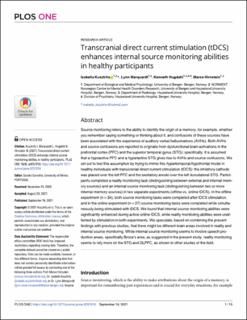| dc.contributor.author | Kusztrits, Isabella | |
| dc.contributor.author | Marquardt, Lynn Anne | |
| dc.contributor.author | Hugdahl, Kenneth Jan | |
| dc.contributor.author | Hirnstein, Marco | |
| dc.date.accessioned | 2022-03-25T08:29:27Z | |
| dc.date.available | 2022-03-25T08:29:27Z | |
| dc.date.created | 2021-10-04T10:35:05Z | |
| dc.date.issued | 2021-09-16 | |
| dc.identifier.issn | 1932-6203 | |
| dc.identifier.uri | https://hdl.handle.net/11250/2987547 | |
| dc.description.abstract | Source monitoring refers to the ability to identify the origin of a memory, for example, whether you remember saying something or thinking about it, and confusions of these sources have been associated with the experience of auditory verbal hallucinations (AVHs). Both AVHs and source confusions are reported to originate from dysfunctional brain activations in the prefrontal cortex (PFC) and the superior temporal gyrus (STG); specifically, it is assumed that a hypoactive PFC and a hyperactive STG gives rise to AVHs and source confusions. We set out to test this assumption by trying to mimic this hypertemporal/hypofrontal model in healthy individuals with transcranial direct current stimulation (tDCS): the inhibitory cathode was placed over the left PFC and the excitatory anode over the left dorsolateral STG. Participants completed a reality monitoring task (distinguishing between external and internal memory sources) and an internal source monitoring task (distinguishing between two or more internal memory sources) in two separate experiments (offline vs. online tDCS). In the offline experiment (n = 34), both source monitoring tasks were completed after tDCS stimulation, and in the online experiment (n = 27) source monitoring tasks were completed while simultaneously being stimulated with tDCS. We found that internal source monitoring abilities were significantly enhanced during active online tDCS, while reality monitoring abilities were unaffected by stimulation in both experiments. We speculate, based on combining the present findings with previous studies, that there might be different brain areas involved in reality and internal source monitoring. While internal source monitoring seems to involve speech production areas, specifically Broca’s area, as suggested in the present study, reality monitoring seems to rely more on the STG and DLPFC, as shown in other studies of the field. | en_US |
| dc.language.iso | eng | en_US |
| dc.publisher | PLoS | en_US |
| dc.rights | Navngivelse 4.0 Internasjonal | * |
| dc.rights.uri | http://creativecommons.org/licenses/by/4.0/deed.no | * |
| dc.title | Transcranial direct current stimulation (tDCS) enhances internal source monitoring abilities in healthy participants | en_US |
| dc.type | Journal article | en_US |
| dc.type | Peer reviewed | en_US |
| dc.description.version | publishedVersion | en_US |
| dc.rights.holder | Copyright 2021 the authors | en_US |
| dc.source.articlenumber | e0257010 | en_US |
| cristin.ispublished | true | |
| cristin.fulltext | original | |
| cristin.qualitycode | 1 | |
| dc.identifier.doi | 10.1371/journal.pone.0257010 | |
| dc.identifier.cristin | 1942923 | |
| dc.source.journal | PLOS ONE | en_US |
| dc.identifier.citation | PLOS ONE. 2021, 16 (9), e0257010. | en_US |
| dc.source.volume | 16 | en_US |
| dc.source.issue | 9 | en_US |

